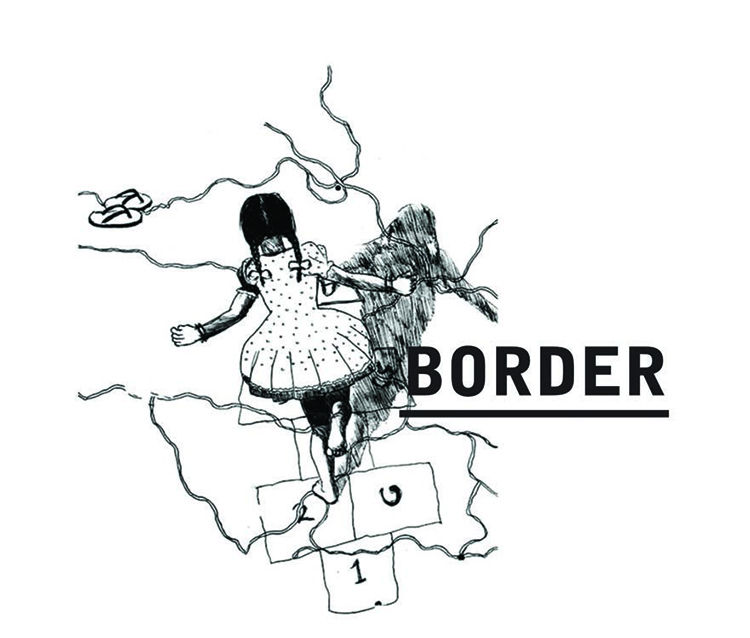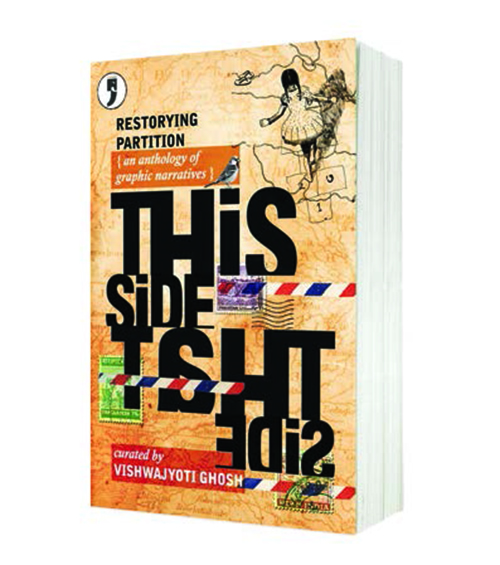Curated by Vishwajyoti Ghosh
Yoda Press (in partnership with Goethe Institut)
Rs. 595
Sixty-six years after the bloody partition and riots that created two Pakistans and an India, forced millions to move to a new homeland identified by their religion, and left hundreds of thousands dead, it is perhaps possible to convert memory into art. In this 336-page collection of variations on the theme of those two partitions – to the west and to the east – and a third that followed in 1971 when Bangladesh was born, 47 writers and artists come together to create 28 graphic accounts and explorations – they cannot all be called novels, novellas or even stories – of the things that happened when those lines were drawn through the map.
In the process of ‘restoring Partition’, curator Vishwajyoti Ghosh has commissioned and collected a variety of narrative forms combining images and text. There are straightforward comic-book style stories, illustrated pastiches of words, documentaries made with matter-of-fact text and stylised photographs, at least two witty pieces that use only images with minimal or no text, and several other experimental forms. Also, refreshingly, he has used not just English texts but also a wide range of works translated from Bengali, Urdu and Hindi, in the process diversifying his sources.
Still, make no mistake, this collection is largely art first and words later. And that raises an important question which must be answered before we can talk about the individual pieces that the book comprises. How can art change our relationship with the Partition of undivided India, which killed and displaced so many human beings, planted giant scars in our collective psyches, and set off a chain of both internal and external violence that has not yet been snapped? Beyond retelling the horror, beyond reliving the dislocation, beyond documenting the severed relationships, is there something else that an anthology such as this one can achieve?
Speaking for myself, I found that best answered in Khademul Islam’s story The Exit Plan, drawn by Sarbajit Sen. Here a Bengali family in Karachi plots its journey to the young country of Bangladesh – home? – fearing a crackdown in Pakistan on people from the land that has just seceded. The story is simple, told in a conventional graphic novel format, detailing the decision and the preparation of the family for the journey back home. It stops before the journey begins and in doing so, does what the best art does – which is to compel the viewer to complete the story.
Just like this tale, the Partition, too, is an unfinished story, one which may have started out in a single thread, but keeps unravelling in each of our heads even today, whether we know it or not, in a different way for every individual. Our perception of the Partition lies, admittedly elusively, in a space where history has ended and the personal experience, often mediated by earlier generations in the family, has taken over. Textbooks cannot take us there, but art certainly can.
And This Side, That Side does that effectively. Most of the pieces here open up different possibilities arising out of those central events, some that we can identify with viscerally, others whose existence we can marvel at. All of these are about the children of the Partition – not just people but entire communities, professions, ways of life, both current and remembered.
Thus, in Arif Ayaz Parrey’s Tamasha-e-Tetwal, drawn by Wasim Helal in frames that often split down the middle, mushrooms are tossed across a river that acts as a border between the separated countries, while a grey eminence of the area mourns the loss of whispers and the advent of propagandist loudspeakers.
In Sanjoy Chakraborty’s An Afterlife, almost a soft Bollywood riff, a boy and a girl from Chittagong meet in Calcutta, but cannot be together forever as he must go back to his parents eventually. What could have been a piece of fluff acquires the poignancy of possibilities spawned by an event as grim as the Partition, but still capable of touching human lives in the most obvious – even clichéd – of ways.
And Nina Sabnani’s Know Direction Home? details the origins of a community of folk artisans who weave stories into fabrics. They turn out to have settled in Gujarat after choosing to leave what was to become Pakistan after the Partition, and finding a new homeland only after dogged and peaceful resistance to attempts to send them back where they came from.
Some of the stories are a bit too obviously symbolic. For instance, the opening story, An Old Fable, written by Tabish Khair and drawn by Priya Kuriyan, draws the far too obvious parallel between two mothers claiming the same child and a colonial judge delivering the decision to split the child.
That an anthology of stories about the Partition would entirely sidestep the traps of irony or of well-intentioned moralising would be too much to expect. But a clever rendition can take even the trite into the territory of the extraordinary. Thus, a printed version of video artist Bani Abidi’s tongue-in-cheek observation of the way newsreaders in Pakistan and in India present the same subject – tensions on the border – brings home one of the outcomes of Partition: namely, the fracturing of perspective on the same truth. Similarly, Orijit Sen empowers readers to create South Asian faces by combining their choice of upper, middle and lower portions – through pages trifurcated breadthwise – tells the known, but no less potent for that reason, truth: we are the same – it’s just a matter of seeing.
The objective of this anthology, writes Ghosh, was to ‘listen to the subsequent generations and the grandchildren and how they have negotiated maps that never got drawn’. By dint of sheer variety, interleaved with tales of the unexpected, uncanny and untold, the collection proves that there are so many other sides besides the ‘this’ and the ‘that’ to this never-ending story. And yes, don’t miss the art.



